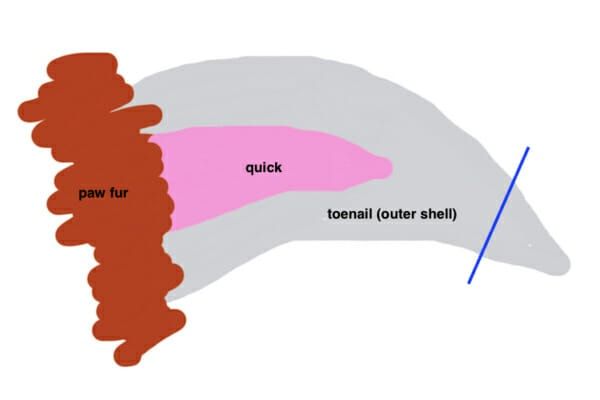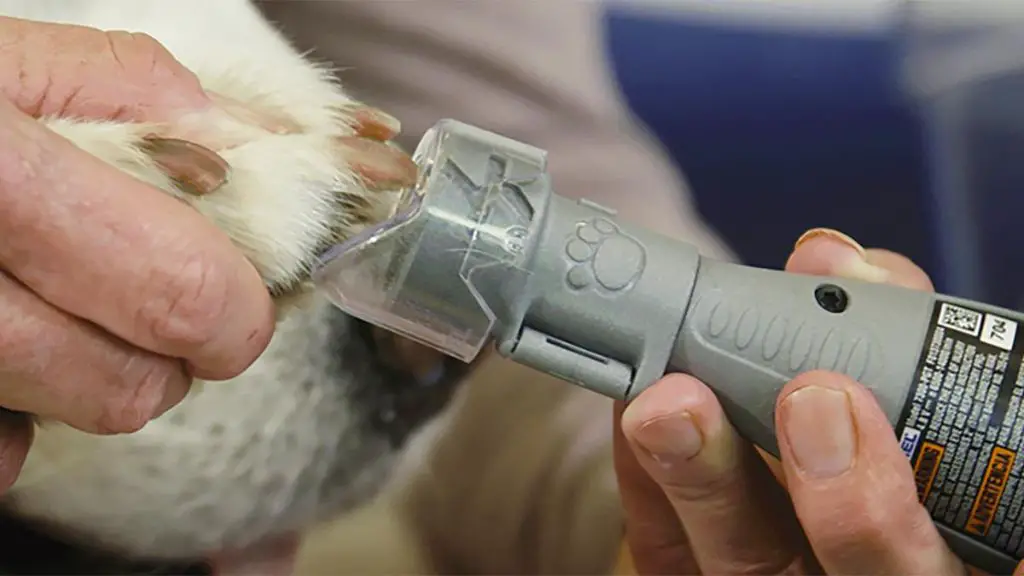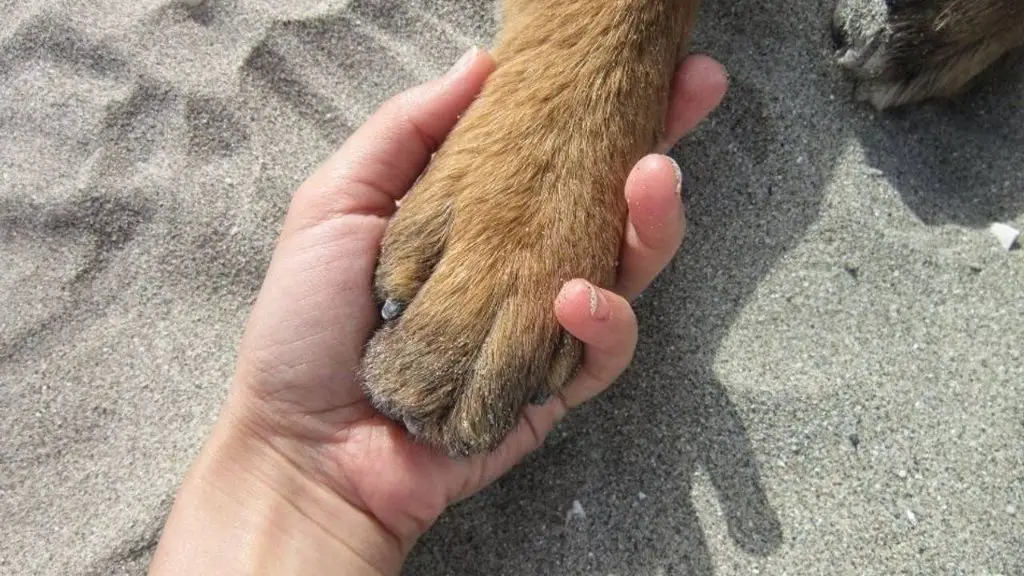What is the quick?
The quick of a dog’s nail is the living tissue inside that supplies blood vessels and nerves to the nail. It’s similar to the cuticle in human fingernails. The quick appears pinkish in color and runs through the center part of each nail. As you get closer to the tip of the nail, the quick recedes, leaving just the nail bed and keratin nail shell.
The dog’s nail consists of several layers. The outermost layer is the nail shell made of keratin (the same protein found in hair and feathers). Underneath the hard shell is a softer nail bed containing blood vessels, nerves, and connective tissue. The blood supply runs through the quick core of the nail. The outer shell protects the delicate quick inside.

When trimming your dog’s nails, it’s important not to cut too far down or you may hit the quick, which can cause bleeding and pain. The goal is to trim just the dead shell safely above the place where the quick ends inside the nail.
Why is hitting the quick a concern?
Hitting a dog’s quick can be extremely painful for them and lead to bleeding from the nail. When you hit the quick with a nail clipper or grinder, it damages the blood vessels and nerves located in the quick, which can cause your dog a lot of pain and discomfort. The bleeding that results from a quicked nail will also understandably worry both you and your dog.
Beyond the immediate pain and bleeding, hitting your dog’s quick can also make them afraid of having their nails trimmed in the future. Your dog associates the nail trimming with the traumatic pain and bleeding, and will see it as a negative experience. This can make them become skittish and uncooperative whenever it is time for a nail trim. It can set you back in training and create a struggle each time their nails grow too long and need trimming. For the sake of their health and your sanity, you’ll want to avoid quicking them so that nail trimming remains a calm routine.
In summary, hitting the quick is very painful for dogs, causes bleeding, and can create fear and aversion to future nail trims. It’s important to trim carefully and avoid the quick in order to keep the experience positive for your pup.
Can nail grinders cut the quick?
Nail grinders use a rotating sanding drum or band to gradually file down a dog’s nails. Rather than making a single cut like clippers do, grinders slowly smooth the nail surface as they’re applied. This gives you more control over how much nail gets removed. So while clippers can easily cut into the quick if you trim too close, grinders tend to be safer in this regard.

With a grinder, you’re less likely to take off a large chunk of nail and hit the quick accidentally. The grinding action tends to push the quick back gradually as you file the nail down. This helps avoid painful nicks and cuts. However, it is still possible to grind down far enough to hit the quick if you’re overly aggressive. The key is to take it slow and check the nail often when getting close to the quick. Look for a pale dot in the center of the nail, which indicates where the quick begins.
So in summary, nail grinders do reduce the chances of cutting the quick compared to clippers. But they don’t completely eliminate the risk, and can still cause injury if used carelessly near the quick. With patience and caution, grinders allow cutting nails shorter while minimizing quicking accidents.
Tips for Avoiding the Quick
When grinding your dog’s nails, it’s important to take steps to avoid hitting the quick. Here are some tips to help prevent painful accidents:
Look for the quick: Before you start grinding, look at each nail closely. You should see a pinkish area inside the nail. This is the quick. Knowing where it is will help you avoid it.
Go slowly: Don’t rush the grinding process. Take it slow and carefully grind only small amounts of nail at a time. Grind in short bursts and check often for signs of discomfort.
Know when to stop: If your dog begins showing signs of discomfort like whining or pulling away, stop immediately. It likely means you’re getting close to the quick. It’s always better to be cautious and stop sooner rather than risk hitting it.
By looking for the quick, grinding slowly, and stopping when needed, you can help avoid those painful quick nicks while safely trimming your dog’s nails.
What to do if you hit the quick
Cutting a dog’s quick during a nail trim can be stressful for both you and your pet. While not ideal, it does sometimes happen, even for the most experienced groomers and dog owners. However, there are steps you can take to stop the bleeding and minimize any discomfort your dog experiences.
First and foremost, stop the nail trim immediately once you notice bleeding. Do not continue cutting any other nails, as this will likely stress out your dog and make the situation worse.

Next, apply steady pressure to the nail to encourage clotting and stop the bleeding. Using a clean cloth or paper towel, hold it firmly over the end of the nail for 2-5 minutes. Do not let go intermittently to check the bleeding, as this can disrupt clotting.
After applying pressure, use a pet-safe styptic powder to help further curb bleeding and discomfort. These powders, often made from ingredients like potassium alum or ferric subsulfate, constrict blood vessels. Gently sprinkle the powder onto the nail tip and repeat the pressure method again.
With the proper response, the bleeding should stop fairly quickly. If it persists longer than 5-10 minutes, contact your veterinarian.
Aftercare for a Quicked Nail
If you accidentally hit your dog’s quick while trimming their nails, it’s important to administer proper aftercare to avoid infection and further trauma. Here are some tips for caring for a nail that has had the quick cut:
Keep It Clean: Gently clean the end of the nail to remove any dirt or debris. You can use a dog ear cleaner or just warm water. Keeping it clean will help prevent infection.
Monitor for Infection: Check the nail daily for signs of infection like redness, swelling, discharge or a foul odor. If you notice anything concerning, contact your veterinarian.
Avoid Further Trauma: Put a small piece of gauze or a specially made nail cap over the tip of the nail to keep it protected while it heals. This will help prevent any additional pain or bleeding.
Proper aftercare is important for your dog’s comfort and health when the quick has been cut. Keep the nail clean and protected as it heals. See your vet if any problems develop.
Training a Dog for Nail Trims
Training your dog to feel comfortable with nail trims is an important step to avoid accidentally quicking them. The key is to take it slow and make it a positive experience through desensitization and positive reinforcement.

Start by letting your dog inspect the nail trimmer while giving them treats so they associate it with something good. Don’t try to trim their nails yet. Over multiple sessions, work up to touching their feet and nails briefly while praising and rewarding them.
When your dog is comfortable with this handling, start trimming just a tiny bit off one nail, followed immediately by a high-value treat. Work up gradually to doing more nails at a time. Go at your dog’s pace and keep sessions short and positive.
With patience and positive reinforcement, you can desensitize your dog to having their nails trimmed. Taking it slow will make the process less stressful for both you and your pup.
When to seek a vet’s help
In most cases, a nicked quick will heal on its own within a few days. However, you should take your dog to the vet right away if you notice any of the following:
Severe bleeding
If the nail bleeds profusely and you cannot get it to stop after applying pressure for 5-10 minutes, seek immediate veterinary care. Uncontrolled bleeding could lead to blood loss and other complications.
Persistent bleeding
While some continued oozing or intermittent bleeding is normal for the first day or two, you should contact your vet if the nail continues to bleed heavily beyond that timeframe. Prolonged bleeding may suggest an underlying clotting disorder.
Signs of infection
Look for redness, swelling, discharge, foul odor, and other signs the nail bed has become infected. Infected nails require antibiotic treatment to prevent the infection from spreading. Left untreated, the infection could travel to the bone.
Don’t wait if you notice any of the above warning signs. Take your dog to the nearest veterinary clinic or emergency animal hospital right away. Severe bleeding and infections need rapid veterinary attention and treatment.
Alternative options to nail grinding and clipping
If your dog is very anxious about having their nails clipped or filed down with a grinder, there are some alternative options to consider:
Filing vs clipping
Filing with a nail grinder is often less stressful for dogs than clipping. The grinding motion doesn’t pinch their nails like clippers do. The sensation can feel more like a vibrating massage. Go slowly and keep the grinder moving to avoid heat buildup.
Sedation at the vet
Some very anxious dogs may need sedation for a nail trim. Your vet can provide medication to relax your dog and make the experience less stressful.
Scratchboards
Scratchboards allow your dog to naturally file their own nails down. These are boards covered in sandpaper that your dog can scratch and dig at. Place them strategically around the house or yard to encourage scratching. They won’t replace trims entirely but can help maintain nails between clippings.
The Takeaway
When grinding your dog’s nails, be very careful not to cut the quick. The quick is the blood vessel inside the nail, and cutting it will be extremely painful for your dog and cause bleeding. Go slowly when grinding, checking frequently to avoid going too short.
If you do happen to hit the quick, try to stay calm for your dog’s sake. Apply styptic powder or corn starch to stop the bleeding. Comfort your dog and watch for signs of continued pain or bleeding. You may need to bandage the nail or seek veterinary care if the bleeding is severe.
If your dog seems very sensitive or you’re struggling to grind their nails without hitting the quick, enlist the help of your veterinarian or groomer. They can show you proper technique and may recommend alternatives like sedation or vet-prescribed anxiety medication to make nail trims less stressful.
With patience and practice, you can master at-home nail grinding. Just remember to put your dog’s comfort first and get professional guidance if needed. Proper paw care is important, but never worth harming your best friend.